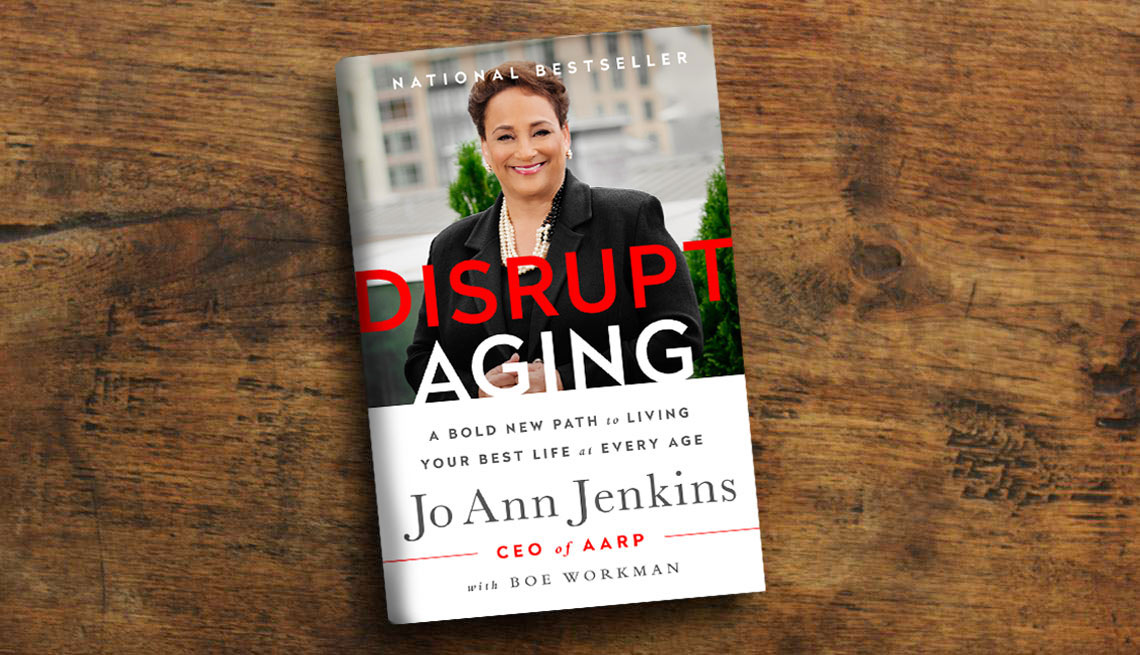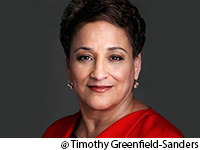Changing Our Views on Aging
AARP CEO Jo Ann Jenkins' new book 'Disrupt Aging' is changing the conversation about what it means to grow older
En español | Q: Why did you decide to write this book now?
I presented the Disrupt Aging speech in September 2014 to about 10,000 AARP members in San Diego. There was this overwhelming sense from the audience of, "Oh my God! That's exactly how I feel." And the response wasn't just from our members but from thought leaders and experts who agreed that the time is right to challenge outdated beliefs about aging.
Q: How did you arrive at the title of the book?
We had been talking about this word "disrupt," meaning to challenge, meaning don't just accept your age — own it, feel good about it. We want to give people courage to embrace their age and not be limited by it. We want people to know that it is OK to change jobs at age 54, as I did when I came to AARP.
Q: It seems like this movement is quite personal for you.
If I feel strongly and passionate about something, and I don't speak up, it will eat at me until I have addressed the issue. If I'm going to be in this role as CEO, I need to feel comfortable about how we're talking about the work that we're doing at AARP.
Q: You've written that we cannot do this work alone.
Yes. Governments at the national and local level have a role to play. The private sector has a role to play. And we need to take some personal responsibility for ourselves. How do we go about bringing change to our own lives or to our communities?
Q: It sounds as if you are talking about starting a movement.
If you think about Disrupt Aging as a movement, one person does not make a movement. So how do we get everyone to start thinking about and reflecting on questions like: "Am I ageist in the way I talk or in the way I interact with people?" And I think if we're all honest we have a bit of it in us. I like to use the example of what we've seen in this country around social change with the same-sex movement. That didn't come about because government mandated it. It really came about because of individuals working together to create social change. And that's the kind of movement we'd like to see with Disrupt Aging.
I hear people talk about the old birthday-card jokes for turning 50. You know — "Happy 50th — you're now officially over the hill." It's just been acceptable for so many years. And we haven't challenged it. We haven't insisted that it's no longer OK to make fun of somebody because they're getting older.
Q: Why do we accept it?
I think older people really haven't had a voice. We just accepted that that's the role we needed to play. We talked about the stages of life as childhood, adolescence, work, retirement. But now we have this new extended middle age, where you have some additional 20-plus years. We didn't think about that years ago, when life expectancy was 67. You were going to draw your Social Security at 65 and probably not live to see 70.
So, back then, you're ridiculing a group of people who probably weren't going to be here much longer. And they really didn't have a say.
But now it's different. The fastest growing age group is now 85 and up. The 100-plus age group is rapidly growing. So how do we make sure we have systems and programs in place that support our longer lives? I try to stress that we shouldn't be defining people and deciding what they can and cannot do by a certain number.
Q: Yet age makes us vulnerable in ways that we couldn't imagine in our 20s and in our 30s. That's part of the story, too.
Certainly we don't want to make light of the fact that aging is a process. But there is no magic number that says at a certain age you're no longer capable of doing things. Yet, the system we put in place really leads you to think that.
Q: What would success for the Disrupt Aging movement look like in five or 10 years?
Obviously, more and more of us are living longer. We want to use that experience and wisdom to solve some of the country's problems. We know there's a desperate need in our schools to mentor students between when kindergarten begins and the end of high school. How can we use this workforce of older people to come into the school system and use their wisdom and experience to teach the young?
Q: Our generation is going to be challenged more than any other in our roles as caregiver. Are there ways that we at AARP can help people in that role?
I absolutely believe that this is one of the areas where AARP can be helpful to our members. If you assume people are going to live to be 100, you could actually have six generations alive at the same time. Yet people aren't prepared. There are huge opportunities to improve the spectrum of services that are being offered. And AARP has a huge role to play in directing people to solutions. The average cost of putting someone in a nursing facility is $86,000 a year. Not many people can afford that for five or 10 years. It's one of the big challenges that we're facing in the 21st century.
Q: The first boomers turned 70 in January, and 10,000 Americans a day are turning 65. Do you hope boomers will be receptive to disrupting aging?
When we talk about the boomers, they've really changed every phase of life. The people I know in their 50s, 60s and 70s are still very active. Few of them have retired and are sitting at home. They're engaged. They're on social media. They're living their lives. Yet I think Disrupt Aging allows people to have that choice. And that is so important to boomers — not to be driven by what society says you ought to do at a certain age but to be able to live the way you want to live.
Q: Sad to say that the news media has contributed to lingering stereotypes about aging.
One of the things we could do better is to celebrate people who are 50 and older and show in a positive way how they are living their lives. I hope we would get to the point where it wouldn't be unusual that a person over 60 or 70 ran a marathon. With 10,000 people turning 65 every day, there are going to be more and more people running marathons, so it will be more of the norm.
Q: Many advertisers still feel free to portray older people as dotty or frail or silly. Yet we buy most of the cars they advertise. We buy their computers. We take vacations.
I remember four or five years ago, AARP was talking about a relationship with a car company around drivers' safety. We put together this unbelievable package. They loved the idea. We wanted them to sponsor it. But they said, "You guys are aging our brand." We showed them that we're not aging your brand: We're the ones buying your cars! And we were able to turn that around. But the first reaction was, "Could you please step aside. You send off the wrong impression."
In the end, though, the $7 trillion in economic activity generated by people 50+ every year is going to make an impact on businesses' bottom lines, and the advertisers will catch on.
Q: Last year AARP started a $40 million investment fund for companies serving our demographic. Can you talk about that?
We're very excited about the fact that in 2015 we launched the Innovation Fund, working with J.P. Morgan Asset Management. We believe that it is the first-of-its-kind fund that is investing in social innovation around the health care area for people 50+. So far we have invested in one company in the health care area. And we expect to be investing in several others in 2016. We are looking for companies that allow people who are 50+ to live healthier.
Q: Do you have any heroes or heroines in the area of Disrupt Aging, or role models who have provided lessons to you on how to do it?
I can't say that I have a particular person that I would say, "Oh, this is the person that inspired me." For me, I get energy, excitement and inspiration from the people I work with and live with every day.
Q: I get the feeling that you are hopeful about this change.
I'm excited about the reaction we've gotten from so many. It's as if we've given them permission to live. A major part of that has been to have AARP focus on many different options for how to live over 50. AARP, which once was just about retired people, is now saying, "It's OK to work. You don't have to retire. You have a choice." I'm very hopeful.
The book Disrupt Aging will be published April 5. It is available for preorder online and at Amazon and Barnes & Noble.
Jo Ann Jenkins is CEO of AARP.


